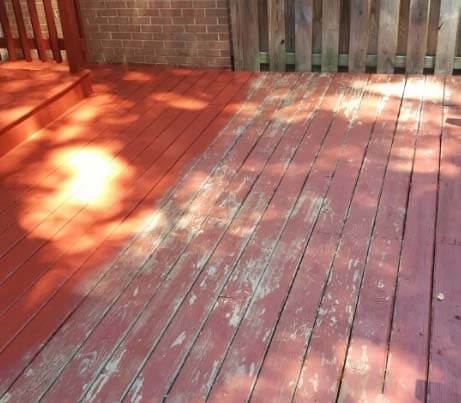Your deck is not just a gathering place; it’s an extension of your home and a symbol of your personal style. To keep it looking its best and to protect it from the elements, staining your deck is the key. However, before you dive into your deck staining project, there are several common mistakes you should be aware of and avoid. TrueDecks is here to guide you through the do’s and don’ts of deck staining.
Not preparing the deck properly
Inadequate deck preparation can lead to significant setbacks during the staining process. Proper deck preparation ensures that the stain adheres effectively and results in a high-quality finish.
- Removing debris and loose wood fibers
- Cleaning the deck thoroughly with a deck cleaner
- Sanding the deck to ensure a smooth surface
- Allowing the deck to dry completely before staining
- Applying a wood brightener
- Protect the surrounding area by covering it with a drop cloth
Choosing the wrong stain
Picking the right stain for your deck can significantly influence its longevity and aesthetics. Failing to choose the appropriate stain may result in a deck that fails to withstand the test of time and weather.
An inappropriate stain not only risks the look of your deck but your investment as well. It’s crucial to consider the wood type, your area’s weather conditions, and the deck’s overall aesthetic before selecting a stain.
- Consider the material of the deck whilst choosing the stain
- Look for high-quality products known for their durability
- Consider the weather conditions in your locale
- Consult with professionals before making the final choice
- Consider the desired aesthetic effect before choosing the stain
Applying the stain in the wrong weather conditions
Weather can avert the proper adherence of stain to your deck. If it’s too hot, the stain could dry too quickly, causing an uneven finish. On the other hand, if it’s too cold, it may not dry properly. So, timing your staining project according to the weather is instrumental.
- Monitor weather forecasts closely to select an ideal day for staining.
- Opt for a day when temperatures range from 50°F to 90°F for optimal results.
- Do not proceed with the job if a storm or heavy rain is predicted within the next 12-24 hours, because it could wash away the stain.
- Avoid staining under direct sunlight, as it can expedite the drying process and lead to uneven staining.
Overapplying the stain
Overapplying the stain on your deck can lead to an array of problems including a blotchy appearance and peeling over time. It’s essential to understand that more isn’t always better in the context of deck staining.
Achieving optimal stain application requires careful attention and expert touch. It helps in sustaining the deck’s aesthetics and durability, ensuring the stain’s vibrancy remains for long.
- To ensure optimal stain application, make sure the deck is clean and dry before you begin.
- Use a high-quality brush or roller for even application.
- Apply the stain in thin, even coats for the best results.
- Allow ample drying time between applications.
- Do not rush the process; patience pays off with a well-stained deck.
Not allowing the stain to dry completely
With deck staining, patience is key. Not allowing the stain to dry completely can leave your deck vulnerable, potentially ruining not only its aesthetic appeal but also its structural integrity.
- Incomplete drying can lead to stain peeling, causing unsightly patches on your deck.
- Drying enables the stain to deeply penetrate the wood, providing long-term protection and enhanced durability.
- The science behind drying involves the evaporation of solvents in the stain, allowing the remaining components to harden and adhere to the wood surface.
Tips for avoiding common deck staining mistakes
Keeping a comprehensive checklist handy plays a crucial role. It aids you in staying on track, ensuring every important aspect is covered. Undeniably, deck staining process becomes smoother with a well-sequenced plan of action.
Mastering the art of deck staining is more than just applying a coat of stain. It involves understanding the nuances, leveraging essential tips and tricks that can make the difference between amateurish work and a professional result.
- Deck preparation: Proper cleaning, sanding, and drying out the deck before staining.
- Stain selection: Choosing the right type of stain, considering factors like deck’s type of wood, age, and sunlight exposure.
- Weather forecast: Staining in suitable weather conditions, avoiding rain or high humidity.
- Application process: Doing thin coats and using the right tools for application, considering brushes, or rollers, as necessary.
- Drying time: Allowing sufficient drying time between coats and before using the deck.
To conclude, understanding these pitfalls not only saves you time and money but also ensures your deck looks its best for years to come. Recognizing and avoiding these common staining mistakes is vitally important for achieving a radiant deck that stands the test of time.
Contact TrueDecks today at 240-404-0207 for all your deck construction needs. Let our certified and reliable team bring your dream deck to life with expertise and attention to detail. Don’t wait, call us now!


